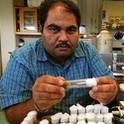
We have devised an undergraduate laboratory exercise to study tissue morphology using fruit fly, Drosophila melanogaster, as the model organism. Drosophila can be reared in a cost effective manner in a short period of time. This experiment was a part of the undergraduate curriculum of the cell biology laboratory course aimed to demonstrate the use of scanning electron microscopy (SEM) technique to study the morphology of adult eye of Drosophila. The adult eye of Drosophila is a compound eye, which comprises of 800 unit eyes, and serves as an excellent model for SEM studies. We used flies that were mutant for lobe (L), eyeless (ey), and pannier (pnr) for our studies. The mutant flies exhibit different morphologies of the adult eye. We employed a modified protocol, which reduces sample preparation steps and makes it practically feasible to complete the protocol in assigned time for the cell biology laboratory. The idea of this laboratory exercise is to: (a) familiarize students with the underlying principles of scanning electron microscopy and its application to diverse areas of research, (b) to enable students to sharpen their observation and quantitative microscopy skills, and (c) minimize the preparation time for the instructor.
Available at: http://works.bepress.com/amit_singh/32/

This document is provided for download by permission of the publisher. Permission documentation is on file.